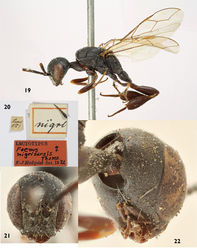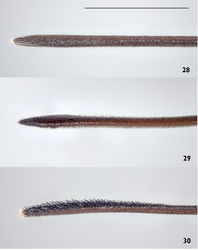Gasteruption nigritarse
| Notice: | This page is derived from the original publication listed below, whose author(s) should always be credited. Further contributors may edit and improve the content of this page and, consequently, need to be credited as well (see page history). Any assessment of factual correctness requires a careful review of the original article as well as of subsequent contributions.
If you are uncertain whether your planned contribution is correct or not, we suggest that you use the associated discussion page instead of editing the page directly. This page should be cited as follows (rationale):
Citation formats to copy and paste
BibTeX: @article{Johansson2016ZooKeys, RIS/ Endnote: TY - JOUR Wikipedia/ Citizendium: <ref name="Johansson2016ZooKeys">{{Citation See also the citation download page at the journal. |
Ordo: Hymenoptera
Familia: Gasteruptiidae
Genus: Gasteruption
Name
Gasteruption nigritarse (Thomson, 1883) stat. rev. – Wikispecies link – Pensoft Profile
- Foenus nigritarsis Thomson, 1883: 849; Schletterer 1889[1]: 398; Hedicke 1939[2]: 7; Hedqvist 1973[3]: 181, 182 (lectotype designation); Wall 1994[4]: 149. Synonymized with Gasteruption assectator (Linnaeus) by Schletterer (1889)[1].
- Gasteruption nigritarse; Schletterer 1885[5]: 310.
Type material
Lectotype female (Figs 19–22) from Lund (Scania) selected by Hedqvist (1973)[3]. All 12 specimens under Foenus nigritarsis, both males and females (including the designated lectotype by Hedqvist) belong to the same distinct species and are well separable from Gasteruption assectator sensu stricto (see key below).
Additional material
Sweden (Småland: Bäckebo; Skåne; Halland; Östergötland: Svensksund; Uppland: Grisslehamn, Svartsjö, Roslagsbro, Skansen; Öland: Borgehage, Himmelsberga).
Diagnosis
Head dorsally more parallel-sided than in Gasteruption assectator, elongate and about as wide as long. Occipital carina indistinct and not reflexed. Mesoscutum superficially reticulate and (especially laterally) rugose, medio-posteriorly in front of scutellum more rugose-reticulate. Mesosoma laterally and face with long, thick golden pubescence. Hind tibia and basitarsus darker, often with the basal ring lacking or interrupted. Fore and middle tibiae often with large distinct ivory patch covering about one third of tibia. Metasoma mainly black with well-defined orange lateral patches on tergites 2–5 which might be partially reduced, especially in northern specimens. Ovipositor sheath entirely black or brown, 0.7–1.0 times as long as hind tibia and its apical half dorsally with stout, black bristles angled backwards at about 45°. The bristles are all conspicuously widened and bent apically, reminiscent of “velcro” (Fig. 30). The species is closely related to Gasteruption assectator (Linnaeus) and Gasteruption boreale (Thomson), but the female can be distinguished by the stout velcro-like bristles dorsally on the apical half of the ovipositor sheath, its denser pubescence of head and mesosoma and its broader hypostomal bridge. The male is distinguishable by its broader hypostomal bridge as well as the thick golden facial pubescence.
Description
Female. Length of body 8–11 mm (fore wing 4.0–5.5 mm)
Head. Temples parallel-sided behind eyes in dorsal view. Occipital carina not raised. Frons and vertex with satin sheen. Malar space short, at most about 0.5 times mandibular base. Hypostomal bridge at least 0.7 times width of mandibular base, medio-laterally often with distinct transverse striae. Face covered with dense golden pubescence.
Mesosoma. Surface vaguely reticulate and strongly shagreened. Antesternal carina narrow and non-lamelliform. Pronotal sides with very small pointed teeth antero-ventrally, but these are sometimes entirely absent.
Legs. Hind tibia rather stout as in Gasteruption assectator. Hind tibial spurs and hind tibia mostly similarly coloured.
Metasoma. Ovipositor sheath entirely black or brown, 0.7–1.0 times as long as hind tibia, its apical half dorsally with stout, black bristles angled backwards at about 45° and conspicuously widened and bent backwards apically.
Colour. Black. Mandible apically orange. Sometimes small patch on hind tibia baso-ventrally white or ivory. Northern specimens of both sexes often with entirely black hind tibia. Fore and middle tibiae often with large distinct ivory patch covering about one third of tibia. Fore, middle and hind tarsus black. Patches laterally on tergites 2–5 reddish brown. Last sternite apically often extensively orange. Colour of hind tibial spurs variable, mostly black or dark brown.
Distribution
Gasteruption nigritarse is a rather rare locally but widespread species in Europe. Specimens examined from Austria, Germany, Czech Republic, Netherlands (Breda, Waalwijk, Putten (GE), Maastricht, Wageningen, Rhenen, Arnhem), Serbia, Sweden and Turkey.
Biology
The species primarily occur in small-scale agricultural landscapes where it is to be found especially on walls of log barns (Fig. 23). An association with the bees Hylaeus difformis and/or Hylaeus pictipes is highly probable, at least in Scandinavia and is based on observed behaviour of the wasps. Gasteruption nigritarse seems to have diminished dramatically in Scandinavia during the last century, probably due to the loss of habitat and is only known from a couple of localities.
Taxon Treatment
- Johansson, N; van Achterberg, C; 2016: Revision of the Palaearctic Gasteruption assectator aggregate, with special reference to Sweden (Hymenoptera, Gasteruptiidae) ZooKeys, (615): 73-94. doi
Images
|
Other References
- ↑ 1.0 1.1 Schletterer A (1889) Die Hymenopteren-Gruppe der Evaniiden. Annalen des Kaiserlich-Königliches Naturhistorischen Hofmuseums 4: 373–546.
- ↑ Hedicke H (1939) Hymenopterorum Catalogus 11, Gasteruptiidae. s’-Gravenhage, 1–54.
- ↑ 3.0 3.1 Hedqvist K (1973) Notes on the superfamily Evanioidea in Sweden with keys to families, genera and species (Hym., Apocrita). Entomologisk Tidskrift 94(3–4): 177–187.
- ↑ Wall I (1994) Seltene Hymenopteren aus Mittel-, West- und Südeuropa (Hymenoptera Apocrita: Stephanoidea, Evanioidea, Trigonalyoidea). Entomofauna 15(14): 137–184.
- ↑ Schletterer A (1885) Die Hymenopteren-Gattung Gasteruption Latr. (Foenus aut.). Verhandlungen der Zoologish-Botanischen Gesellschaft in Wien 35: 267–326.



